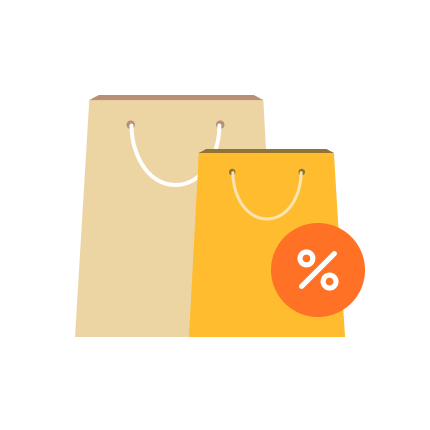Many manufacturers, wholesale suppliers, and retailers require a minimum order quantity (MOQ) for one or more of their products. That means these businesses fulfill only such orders where a customer buys the minimum number of units or pays the minimum sum required under the seller MOQ policy.
At first glance, it may seem that this restriction does not make sense. Why limit your customers from making purchases with you? But let’s understand how MOQ generates a major net advantage for so many businesses and learn how to make MOQ work effectively.
What is MOQ?
The Minimum Order Quantity (MOQ) is the smallest quantity of a product (measured in item counts, weight units, or dollar value) required for a sales transaction. Manufacturers, wholesalers, and e-commerce retailers use MOQs to increase profit margins. They accomplish that goal through MOQ by increasing the value of their products to their customers.
A manufacturer needs to produce products in sufficient quantities to make a profit. Of course, your retail business shares your manufacturer’s interest in lower-cost production. Each generates larger-volume sales per transaction, with or without a smaller markup.
Although it may seem that not selling to anyone who wants to buy would defy fundamental retail principles, MOQs are very common in retail. Let’s see why and how.
MOQ Pricing in Retail
Thanks to MOQ, a seller can refuse to sell to customers who want to buy amounts under the required minimum. Intuitively, this approach seems to undermine sales and overall profitability. However, when appropriately applied, MOQ practices often boost sales and increase profits by large margins. Moreover, shifting to MOQ for at least some products can boost sales so much that a retailer can get a much healthier cash flow (the tell-all metric).
How can that possibly work?
To illustrate, imagine an e-commerce business setting the MOQ for a particular product at 200 units per order. In doing this, the business ensures that its order sizes are large enough to make inventory, fulfillment, and supply chain efforts more efficient and cost-effective. This leads to several benefits, including minimized stockouts, reduced handling costs, and improved cash flow.
Let’s take a closer look at all of the many MOQ benefits.
MOQ Benefits
What does MOQ mean to retailers overall? Here’s a look at the important benefits that MOQ can deliver for any e-commerce company:
Promotes Bulk Sales and Customer Savings | Ultimately, the meaning of MOQ is to promote higher-volume sales per ticket by setting a bottom dollar limit on purchases. This translates into Cost of Goods (COG) savings, which means added value for customers. |
Increased Sales | When appropriately applied, having customers buy at least a set minimum per purchase can raise revenue and increase a business’s cash flow. |
Increased Profits | Bulk ordering saves manufacturing costs, which ultimately increases your profit margins on each sold unit. This can help you achieve your growth goals for your company. |
Minimized Returns/Refunds | Customers who buy a larger amount of a product tend to be less likely to take back the whole batch, which minimizes returns and preserves your profit margin. |
Lower Inventory Cost | Ordering inventory at lower costs helps you save on acquisition expenses because manufacturers get discounts on raw materials and suppliers save when buying in bulk from producers. |
Cheaper Inventory Management | Having customers buying in larger quantities makes inventory management simpler. It becomes easier to avoid overstocks or stockouts, both of which are quite costly. |
Reduced Shipping Cost | Larger purchases allow you to ship larger batches, reducing the number of orders to be managed by your shipping staff. This can save time and cost for packaging, shipping, and delivery, minimizing shipping errors and losses on refunds. |
Increased Customer Satisfaction | With better inventory control and larger ship batches, you can fulfill orders faster and more accurately. That builds trust and cultivates loyalty. |
Stronger Position with Suppliers | When you order from your suppliers in larger quantities, you can negotiate better prices and payment terms, which is essential for maximizing your net profit margins. |
Types and Examples of MOQ
Categorizing can help manage MOQ product lines properly. Classes of MOQ products can be identified, for example, by minimum order amounts, materials, shipping costs, invoicing, accounting costs, and other factors.
To streamline your MOQ product management system, identify them this way and group them for faster handling:
Simple MOQ – Only One Constraint
With some products, implementing a simple MOQ by setting a minimum order quantity or price total is sufficient to ensure profitability. This approach involves only one constraint, making it easy to manage.
For example: You might start to require customers to purchase at least 50 units of a particular item or spend a minimum of $500 per order. This straightforward strategy will help you maintain profit margins without complicating the ordering process.
Complex MOQ – Two or More Constraints
With other products, managing MOQ involves more complex processes. Complex MOQ ensures that all aspects of the product's supply chain and production are optimized for profitability. These may require more restrictions to offset costs and widen margins: from a high-volume MOQ order to a severe markup, to custom ordering and production.
For example: A pharmaceutical company might set an MOQ for a specific medication that includes raw material costs, production runs, and regulatory compliance. They might require a minimum order of 5,000 units to ensure the batch production and QA are financially viable.
3 Key Factors Affecting MOQ
These are three fundamental considerations when deciding on an MOQ product purchase restriction:
- Raw Materials Management – Consider the lead time for sourcing raw materials, fluctuations in material prices, and the impact on production costs. Setting MOQs that align with the procurement process for raw materials ensures smooth production operations and prevents disruptions due to material shortages.
- Inventory Turnover and Holding Costs – Analyze your inventory turnover ratios and calculate the carrying costs associated with holding inventory. Setting MOQs that align with optimal inventory turnover rates helps minimize holding costs and prevent excess inventory buildup.
- Customer Demand and Preferences – Conduct market research, gather customer feedback, and analyze sales patterns to determine the appropriate order quantity. If you set MOQs that meet customer demand, you’ll ensure high product availability and customer satisfaction while minimizing the risk of overstocking or stockouts.
Clothing manufacturers, for example, may need to consider what limits to maintain on holding inventory of a product, since wholesalers typically don’t carry much. Both manufacturers and retailers holding inventory must prioritize turnover that matches demand closely enough to avoid seasonal overages, material deterioration, trends becoming obsolete, etc.
How to Calculate MOQ Properly
Calculating planned expenses and projected income for a product is too complex for manual calculations to be accurate. Therefore, technology – specifically an inventory management system – is necessary for ongoing calculations that support MOQ decisions.
Your inventory management software will access relevant data and use mathematical methods to derive accurate calculations. Your task is to apply the MOQ formula to each product, considering all relevant factors.
1. Gather all relevant data for setting the MOQ for each product you are evaluating.
2. Examine individual product costs and profit margins to determine necessary changes in pricing and purchase quantity policies. Include both direct and indirect costs in your formula to determine the MOQ needed to profit from each sale.
3. Implement strategic changes:
- Stop accepting orders that are too small to be profitable.
- Offer loyalty discounts, free shipping for larger orders, and other incentives to keep customers.
- Use ads and promotions to attract new customers to the MOQ products.
- Utilize various marketing methods to encourage purchases under the new MOQ rules.
4. Add incentives for loyal current MOQ customers, such as:
- Reward points for repeat bulk-order customers.
- Special promotional campaigns.
- Conduct an overstock sale to shrink excess inventory.
MOQ Optimization Best Practices
Periodic reviews of MOQs can ensure they align with changing market conditions, production costs, and customer demand. Industry best practices for quality processes in optimizing minimum order quantity (MOQ) include:
- Consider Total Cost of Ownership (TCO). Evaluate the TCO, including procurement, storage, handling, and obsolescence costs, when setting MOQs. Balance the benefits of bulk purchasing against the risks and costs associated with holding larger inventories.
- Leverage Advanced Analytics. Utilize inventory management software with advanced analytics capabilities to monitor and predict demand patterns. Methodically determine the product demand level to maintain inventory and prevent stockouts.
- Negotiate with Suppliers. Work closely with suppliers to understand their production processes and constraints, enabling better alignment of MOQs. Routinely examine their pricing, terms, quality, services, and reliability, and renegotiate with any who are not sufficiently helping grow your business’s profit margins.
- Optimize Your Supply Chain. Align MOQs with optimal order and delivery cycles to reduce lead times and improve supply chain efficiency. Diversify suppliers and create contingency plans to manage disruptions and maintain optimal inventory levels.
- Improve Your Inventory Management. Segment inventory based on factors such as demand variability, lead times, and profitability. Audit inventory to ensure that everything indicated in the reports of warehouse contents is really in there and is in salable condition.
MOQ Success Stories
The world’s most profitable mega-retailers use minimum order quantity strategies to manage the profitability of many products. For example:
Amazon
Amazon is a global example of supreme manufacturing cost management, inventory tracking, and effective pricing. Their experts are sharply aware that selling below the appropriate MOQ can negatively impact their ability to deal with many vendors and diminish mutually beneficial relationships.
Amazon has struck the balance by following these strategies:
- Bulk Purchasing Discounts – Amazon negotiates bulk purchasing agreements with suppliers to reduce per-unit costs.
- Automated Replenishment – Amazon’s sophisticated inventory management system uses real-time data to automatically reorder products when inventory levels reach a certain threshold.
- Supplier Collaboration – By working closely with suppliers, Amazon can adjust MOQs based on demand forecasts and market trends.
Alibaba
MOQ at Alibaba means the lowest quantity a commercial customer can order from a wholesaler on the platform. Many suppliers working with Alibaba don’t maintain large inventories of finished goods. Their manufacturing runs are based on current orders. So, their MOQ decisions are especially sensitive to undersized orders and are based on these principles:
- Platform Flexibility – Alibaba’s platform allows suppliers to set and adjust MOQs based on their production capabilities and market demand.
- Economies of Scale – By encouraging larger order sizes, Alibaba helps suppliers achieve economies of scale, reducing costs for both suppliers and buyers.
- Buyer-Supplier Matchmaking – Alibaba’s algorithm matches buyers with suppliers who can meet their MOQ requirements, streamlining the purchasing process.
Zara
Zara, a leader in fast fashion, uses MOQ strategies to balance inventory levels with quickly changing fashion trends. They set MOQs that reflect current demands and seasonal preferences to minimize excess inventory and respond quickly to market changes.
Here are Zara’s main approaches to MOQ:
- Agile Supply Chain – Zara’s agile supply chain allows for smaller MOQs and more frequent orders, reducing the risk of overproduction.
- Trend Analysis – Zara uses real-time sales data and trend analysis to set MOQs that align with customer preferences.
- Local Production – By producing many items locally, Zara can set lower MOQs and quickly restock popular products.
Moving Forward with MOQ Implementation
Implementing MOQ sales policies on certain income channels can benefit your retail business in operations and your KPIs. Using MOQ strategies can lead to more efficient inventory control, increased fulfillment efficiency, more accurate sales forecasting, and strengthened negotiating power with vendors.
But what’s even better, those improvements can result in even more significant benefits: increased sales volume, higher average ticket size, reduced production costs, reduced returns, increased customer retention rates, and, of course, increased profit margins.



























